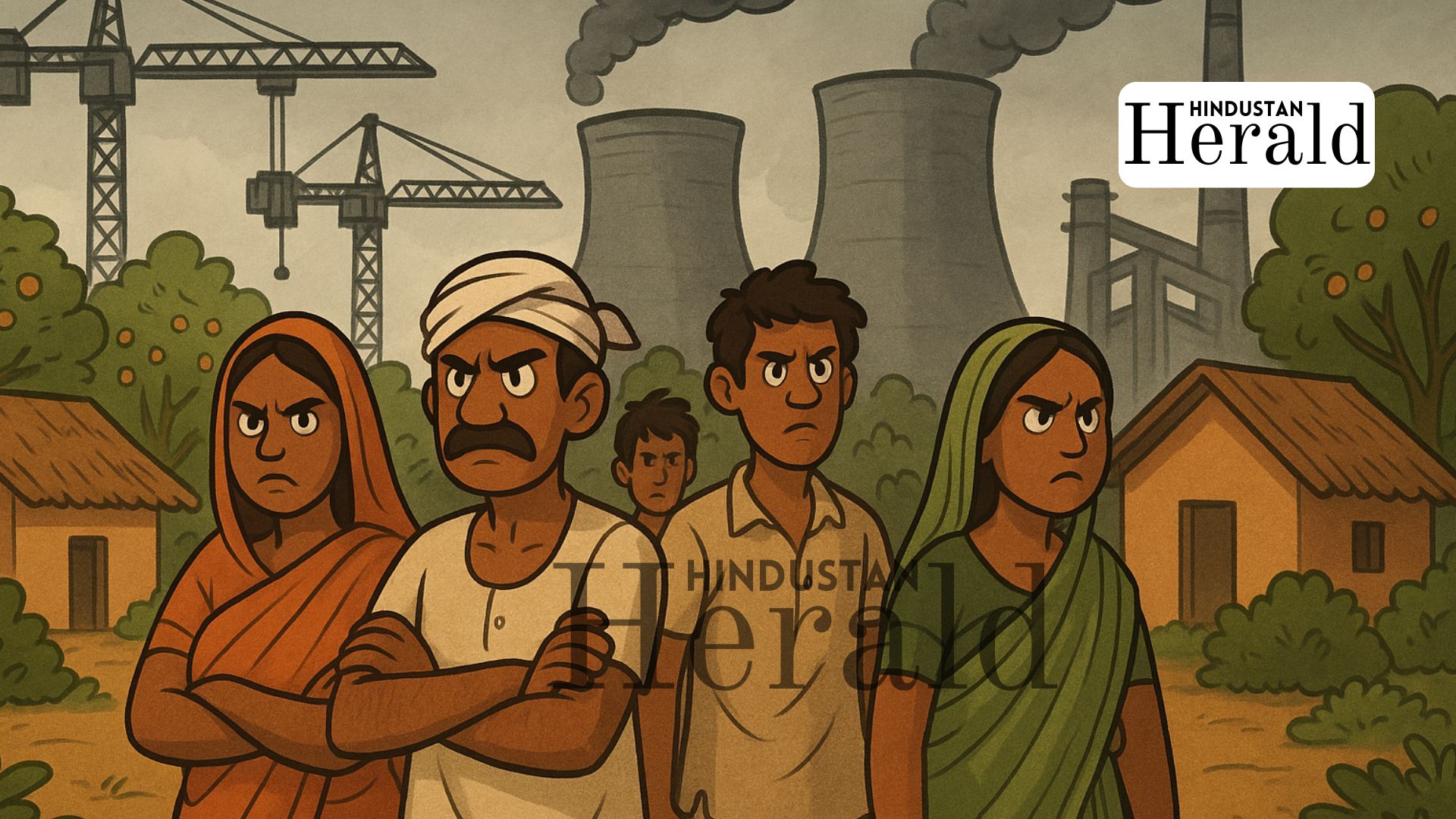Patna, October 7: In Kamalpur, a quiet village in Bhagalpur’s Pirpainti block, the air feels heavy these days with dust, confusion, and anger. The Bihar government has leased nearly 1,000 acres of farmland here to Adani Power Ltd. to set up a 2,400-megawatt thermal power plant, and the people who’ve lived on this land for generations say they are being erased in the name of development.
They call it injustice. The government calls it progress.
“We Won’t Leave Our Homes”
In Kamalpur, you don’t need to go far before someone stops you to talk. A farmer, eyes reddened from sleepless nights, says, “We were born here. We raised our children here. Where should we go now?” His house, like dozens of others, is marked for demolition. The notice came in mid-September a simple slip of paper telling families to vacate.
The government has offered ₹5.4 lakh for land and about ₹4 lakh for the house. “What can we buy with that?” another villager asks. “Not even half a plot in Bhagalpur. We’ll be on the road.”
For most families here, this isn’t just about compensation. Their survival is tied to the orchards and the soil. One woman points to rows of mango and guava trees behind her home. “We get our food from this garden,” she says. “We earn around ₹6–7 lakh a year. If these trees are gone, what do we live on?”
A Project That Split a State
The Bihar cabinet approved the land transfer to Adani Power on August 5, 2025. Under the deal, the company will lease the land for ₹1 a year for 25 years. The Energy Department says this is standard practice a way to attract big investment and push Bihar up the industrial ladder.
The plant, expected to cost around ₹25,000 crore, promises 2,400 MW of power and 10,000–12,000 jobs during construction. Officials argue this could finally give Bihar the base load energy it has struggled to generate for decades.
But to the opposition and to hundreds of families in Pirpainti, the project looks like something else entirely. “All the mining is on one side and Gautam Bhai is on the other,” a local leader from the RJD said recently. “You are being looted in front of your eyes.” The Congress and CPI(ML) have called the ₹1-per-year lease “an insult to the people of Bihar”.
The Nitish Kumar government has defended the move as a long-term bet. “Every state gives land at low cost to attract large investment,” an Energy Department official said. “This is not a gift. It’s an incentive.”
Still, the optics are grim. The state spent crores acquiring that land from farmers nearly fifteen years ago, only to lease it to one of India’s biggest private power companies for a token sum.
Trees, Rivers, and the Price of Power
Environmental worries hang over the project like thick smoke. Nobody seems sure how many trees will be felled. Villagers talk about “lakhs of trees.” District officials insist the number is closer to 10,000. Somewhere between those figures lies the truth and perhaps the fate of Bhagalpur’s micro-climate.
“Look around,” a farmer says, gesturing at the shade around his field. “All these trees will go. How can we live here when everything turns into ash?”
Government records reviewed by the BBC suggest there could be more than 300,000 trees across 400–500 acres of the project area. Officials say each tree will be counted and compensated. But locals scoff at that idea. “How do you pay for shade?” one asks quietly.
The Ganga runs barely 10 kilometres away. People worry that the plant’s cooling water and fly-ash discharge could poison it. No one here seems to know what safeguards have been planned. “If the river is polluted, our crops will die. Then what will we eat?” says 60-year-old Sudhir Mandal, who has already lost part of his land.
Unequal Rates, Unequal Justice
Even among those who agreed to part with their land years ago, anger is rising again. They say compensation was arbitrary: ₹62 lakh per acre in one place, ₹42 lakh in another. Some got as little as ₹1 lakh.
District officials say the variation is due to two different acquisition periods, 2010 and 2013, each under a separate law with distinct valuation methods. “We’ve followed the rules,” the local district officer told reporters. “The rate difference is because of the act, not discrimination.”
But for those living it, the technicalities mean little. “They bought our land under the old law, sat on it for years, and now Adani gets it for ₹1,” a farmer said bitterly. “How is that justice?”
What the Company Promises
Adani Power Ltd. says the project will be a “landmark investment” for Bihar, one that could lift local economies and make the state energy-secure. The company has committed to afforestation and says only trees inside the plant area, roughly 300 acres, will be cut.
It also promises to prioritise local hiring once operations begin. “Thousands of jobs will be created, directly and indirectly,” the company said in a statement earlier this year. It maintains that the land remains government-owned and is only leased for industrial use.
Still, no one from Adani has visited Kamalpur in recent weeks. Villagers say they’ve heard promises before, and they’ve learned to be wary. “They come, take our photos, and leave,” a young man said. “Nothing changes.”
Politics in the Background
The timing of the deal, just months before state elections, has turned the project into a political battlefield. Opposition parties have organised marches in Patna and Bhagalpur, accusing the NDA government of “selling Bihar for cheap.”
Chief Minister Nitish Kumar, who has built his image on development, now faces the uncomfortable task of defending a decision that benefits one of India’s most politically controversial business groups. His allies insist this is not about favouritism but about modernising a state that still faces power cuts every summer.
Behind the noise, the question of trust remains. For decades, promises of industrialisation have come and gone in Bihar. Many wonder whether this, too, will leave behind only scorched earth and broken homes.
What Lies Ahead
There’s a strange mix of fear and defiance in Kamalpur. People know they are up against powerful forces a government, a corporate giant, and the idea of “progress” itself. But they also know what they stand to lose.
Some plan to go to court. Others are trying to organise a village committee to resist eviction. A few have pinned their hopes on the media to make sure their voices aren’t lost in paperwork and press releases.
At night, the conversation in many homes turns to the same questions: Will the bulldozers come next week? Will there be police? Where will we go if they do?
For now, the only answer they have is resistance. “We will not leave our homes,” one woman repeats, her voice shaking but steady. “This is where we were born. This is where we’ll die.”
Stay ahead with Hindustan Herald — bringing you trusted news, sharp analysis, and stories that matter across Politics, Business, Technology, Sports, Entertainment, Lifestyle, and more.
Connect with us on Facebook, Instagram, X (Twitter), LinkedIn, YouTube, and join our Telegram community @hindustanherald for real-time updates.
Covers Indian politics, governance, and policy developments with over a decade of experience in political reporting.
Former financial consultant turned journalist, reporting on markets, industry trends, and economic policy.











